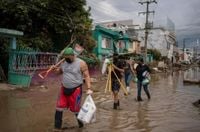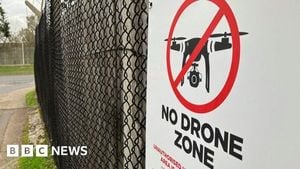When disaster strikes, it often lays bare the strengths and weaknesses of a nation’s preparedness—and sometimes, its deepest vulnerabilities. Last week, torrential rains battered east-central Mexico, unleashing deadly floods and landslides that left at least 76 people dead and dozens missing, according to reporting from the Associated Press and Latin Times. In the Gulf Coast state of Veracruz alone, 40 communities were severely impacted, with at least two major rivers overflowing and 22 municipalities urgently requesting government assistance.
As the floodwaters rose, so did the questions. Could more lives have been saved if warnings had come sooner? Are Mexico’s severe weather alert systems keeping up with a climate that’s growing more volatile by the year? And, perhaps most troubling of all, why are criminal organizations stepping in to fill the gaps left by the state, distributing aid in the aftermath of catastrophe?
Experts say the disaster is a wake-up call. “We’re being more and more affected by these phenomena, and we can’t go on like this, failing by not knowing what to do and not having … adequate warning,” Christian Domínguez, a researcher at the Atmosphere and Climate Change Institute at Mexico’s National Autonomous University, told the Associated Press. Domínguez recalled that last year’s crises were drought-related, while this year it’s the rain—underscoring how climate change has upended old patterns and made extreme weather the new normal.
Indeed, the numbers are sobering. In Veracruz, the day before the main rivers jumped their banks, forecasts predicted nearly eight inches of rain. The actual amount? Three times that. By October 10, nearly 500 people had been moved into shelters, according to President Claudia Sheinbaum, as thousands of soldiers and officials scrambled to reopen roads blocked by landslides and washed-out bridges. Yet, in many places, residents only began to flee when the water was already at their doors. Some said authorities warned them too late; others simply didn’t believe it would get so bad.
“A severe weather event can develop anywhere when the ingredients come together,” Jonathan Porter, chief meteorologist with AccuWeather, told the Associated Press. He noted that climate change is pushing severe weather outside of its usual seasons and into places not typically associated with flooding. The result? More unpredictability, more devastation, and a greater need for robust prevention strategies.
But prevention requires more than just technology. Domínguez pointed out that Mexico lacks sufficient real-time monitoring tools, like river-level gauges and weather radars, which would allow meteorologists to make better predictions. Even so, she argued, existing forecasts could be put to better use if officials considered the possibility that multiple weather systems could combine to create dangerous situations—exactly what happened this month in Veracruz.
Communication is also a major stumbling block. Mexico has risk maps, and civil defense officials are tasked with alerting the public. But as Domínguez noted, “beyond alerting, the people have to also understand what is being said.” After Hurricane Otis devastated Acapulco in 2023, some residents admitted they didn’t realize a Category 5 hurricane meant their homes could be obliterated. The lesson? Not only do officials need more training, but the public needs education on what warnings actually mean—and how to respond.
President Claudia Sheinbaum, who holds a doctorate in environmental engineering and has a background in climate change, expressed willingness last week to review prevention protocols. However, she stopped short of explicitly linking the disaster to climate change, insisting that it was impossible to predict with precision how much rain would fall in any given place. “The language being used has to be considered” in communicating danger, Carlos Valdés, former head of Mexico’s National Disaster Prevention Center, told the Associated Press. “The first thing we have to do is recognize that there is a change. … The atypical is now the most typical.”
While government agencies worked to reopen roads and move people to safety, another force was making its presence felt in Veracruz—one that has long exploited moments of crisis. Videos circulated in mid-October showing alleged members of the Cártel Jalisco Nueva Generación (CJNG) handing out emergency aid packages, emblazoned with the cartel’s insignia, to flood victims in Álamo. “On behalf of the Lord of the Palms and the Cártel Jalisco Nueva Generación,” the men announced in one video, as they distributed food and basic supplies, according to Latin Times.
This is hardly a new tactic. As Latin Times reported, criminal organizations in Mexico have historically used natural disasters as opportunities to expand their influence in vulnerable communities. The CJNG’s aid deliveries are just the latest example, and they come at a time when the cartel is stronger than ever. According to the U.S. Drug Enforcement Administration’s annual report, CJNG is now the only cartel with a presence in all 32 Mexican states as of 2025.
The situation in Veracruz is further complicated by the presence of at least seven criminal organizations, including the Gulf Cartel, the Northeast Cartel, and the Sinaloa Cartel. Violent clashes are common in municipalities such as Poza Rica, Tuxpan, and Álamo—many of them among the hardest hit by this month’s flooding. The fragmentation of the Gulf Cartel and Los Zetas has spawned smaller, more violent factions like Grupo Sombra, which have filled the power vacuum and contributed to ongoing instability.
Federal investigations suggest that these groups often operate with the tacit support of municipal police forces and local officials. In August, Latin Times highlighted how criminal groups in Veracruz have been aided by public officials. This uneasy alliance has fueled suspicions and heightened tensions, especially in the wake of recent violent incidents. One of the most serious occurred earlier this year in Tuxpan, where a prison riot left seven inmates dead and 11 injured; inmates claimed they were being extorted by members of Grupo Sombra, prompting a federal investigation, as reported by El País.
The strategic importance of Veracruz cannot be overstated. Its ports, once famed in prehispanic times for supplying fresh fish to Aztec emperors, are now under cartel control due to their proximity to commercial shipping lanes and key trafficking routes. This confluence of geography, crime, and disaster has made Veracruz a microcosm of the challenges facing Mexico as a whole.
As the floodwaters recede, the questions linger. Can Mexico modernize its weather alert systems and educate the public before the next disaster strikes? Will government efforts to improve prevention and response outpace the opportunism of criminal groups? For now, the tragedy in Veracruz stands as a stark reminder that, in a world transformed by climate change and organized crime, the old playbooks simply aren’t enough.




